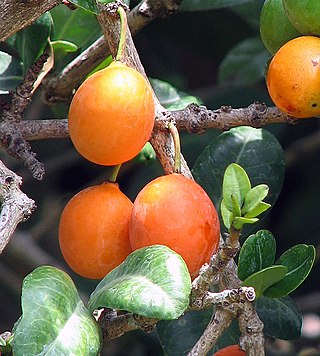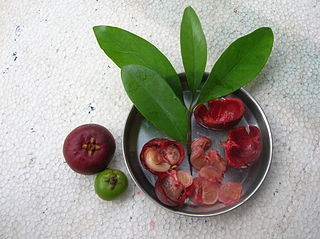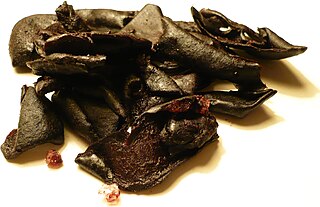
A mango is an edible stone fruit produced by the tropical tree Mangifera indica. It is believed to have originated between northwestern Myanmar, Bangladesh, and northeastern India. M. indica has been cultivated in South and Southeast Asia since ancient times resulting in two types of modern mango cultivars: the "Indian type" and the "Southeast Asian type". Other species in the genus Mangifera also produce edible fruits that are also called "mangoes", the majority of which are found in the Malesian ecoregion.

Mangosteen, also known as the purple mangosteen, is a tropical evergreen tree with edible fruit native to tropical lands surrounding the Indian Ocean. Its origin is uncertain due to widespread prehistoric cultivation. It grows mainly in Southeast Asia, southwest India and other tropical areas such as Colombia and Puerto Rico, where the tree has been introduced.

Garcinia is a genus of flowering plants in the family Clusiaceae native to Asia, America, Australia, tropical and southern Africa, and Polynesia. The number of species is disputed; Plants of the World Online (POWO) recognise up to 400. Commonly, the plants in this genus are called saptrees, mangosteens, or garcinias, and is one of several plants known as by the name "monkey fruit".

The jackfruit, also known as the jack tree, is a species of tree in the fig, mulberry, and breadfruit family (Moraceae). Its origin is in the region between the Western Ghats of southern India.

Mammea americana, commonly known as mammee, mammee apple, mamey, mamey apple, Santo Domingo apricot, tropical apricot, or South American apricot, is an evergreen tree of the family Calophyllaceae, whose fruit is edible. It has also been classified as belonging to the family Guttiferae Juss. (1789), which would make it a relative of the mangosteen.

Mangostin is a natural xanthonoid, a type of organic compound isolated from various parts of the mangosteen tree. It is a yellow crystalline solid with a xanthone core structure. Mangostin and a variety of other xanthonoids from mangosteen have been investigated for biological properties including antioxidant, anti-bacterial, anti-inflammatory, and anticancer activities.

Garcinia intermedia is a species of tropical American tree which produces tasty fruit. In English it is known as the lemon drop mangosteen or sometimes monkey fruit. In Spanish it is called mameyito, though it is known as jorco in Costa Rica. In the Philippines, it is known as berba. In Portuguese it is called achachairu. The name achachairu is also applied to Garcinia humilis, another species native to Bolivia with larger, round or egg-shaped fruit. G. humilis has been commercialized in Australia under the name Achacha.

Garcinia livingstonei is a species of Garcinia, native to a broad area of tropical Africa, from Côte d'Ivoire east to Somalia, and south to South Africa.

Garcinia morella is a species of tree in the family Clusiaceae found in India, and Sri Lanka.

Garcinia indica, a plant in the mangosteen family (Clusiaceae), commonly known as kokum, is a fruit-bearing tree that has culinary, pharmaceutical, and industrial uses. It primarily grows in the Western Ghats, especially the Goa and Konkan region.

Elaeocarpus serratus is a tropical flowering plant in the family Elaeocarpaceae. It is a medium to large tree, with white flowers. It has a disjunctive distribution, with the species occurring in Sri Lanka and southern India, and in Assam, Bangladesh and other parts in the north of the Indian subcontinent. The fruit is commonly eaten, and people also use the plant for ornamental, religious and folk-medicinal purposes. There are historical records of traditional-medicine use of the plant. Paradoxurus jerdoni consumes parts of the tree.

Kokum oil is a seed oil derived from the seeds of the kokum tree. Kokum oil is edible and can also be used for things other than cooking.

Garcinia warrenii, a is a fruit-bearing tree, up to 15 metres in height, of the mangosteen family (Clusiaceae), commonly known as native mangosteen or Warren's mangosteen. It is found in the tropical rainforests of northern and north-eastern Australia and New Guinea. The genus Garcinia, belonging to the family Clusiaceae, includes about 200 species found in the Old World tropics, mostly in Asia and Africa. Garcinia warrenii is indigenous to New Guinea, the Torres Strait Islands, northeastern Queensland from Cape York Peninsula south to Babinda, and a small, isolated population on Melville Island in the Northern Territory, Australia.
Garcinia parvifolia, the Kundong, Brunei cherry or Asam aur aur, is a tropical evergreen tree native to Borneo, Peninsular Malaysia, Sulawesi and Sumatra. The tree is found at elevations of 600–800 metres (2,000–2,600 ft) in humid environments, and grows to a height of 33 metres (108 ft). The bark, wood, leaves, and fruit of the kundong tree are used by humans.
Garcinia binucao is a species of flowering plant in the Clusiaceae family. It is commonly known as binukaw or batuan, is a species of Garcinia endemic to the Philippines. It is not cultivated, though its edible fruits are harvested from the wild for use as a souring agent in some Filipino dishes.

Garcinia xanthochymus, the false mangosteen, gamboge, yellow mangosteen, Himalayan Garcinia, or sour mangosteen is a species of mangosteens found from India, southern China, and Japan through Indochina to Peninsular Malaysia at elevations of 0 - 1400 meters. Plants are found growing in humid forests of valleys or on hills. It is locally known as defol (ডেফল) in Bengal, tepor tenga in Assam, and heirangoi (হৈরাংগোই) in Manipur.

Garcinia sessilis, commonly known as heilala in Tongan, is an evergreen tree native to the Pacific regions of Solomon Islands, Fiji, Samoa and Tonga. The heilala flower is the national flower of Tonga.

Garcinia cowa, commonly known as cowa fruit or cowa mangosteen is an evergreen plant with edible fruit native to Asia, India, Bangladesh, Myanmar, Malaysia, Vietnam, Laos, Cambodia, and southwest China. The tree is harvested from the wild for its edible fruits and leaves, which are used locally. Flowers are yellow, male & female flowers are separated.
Garcinia assamica is a newly discovered species of plant found in areas near Manas National Park, Assam. It seems to be rare and is hitherto only known from very few individuals, near to a rivulet. This new species is allied to Garcinia nigrolineata in arrangement of flowers on axillary short spikes; arrangement of stamens on a convexdisc and number and arrangement of staminodes in female flowers; but it is distinct from the latter in having greenish-yellow exudate; 2–5 female flowers fascicled at nodes against solitary flowers; 4–5-locular ovaries against 5–7-locular ones.
Garcinia forbesii, commonly known as the rose kandis or just kandis, is a small to medium-sized tree in the family Clusiaceae or Guttiferae. The specific epithet (forbesii) honors Scottish naturalist Henry Ogg Forbes.

















